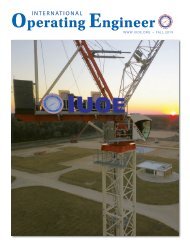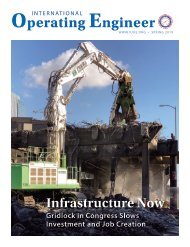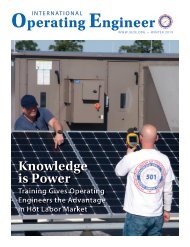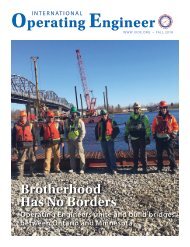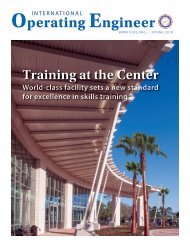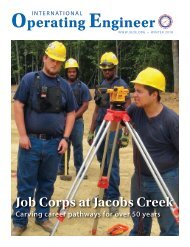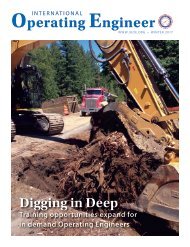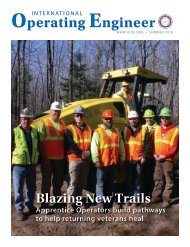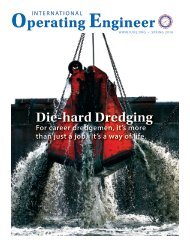125 Years Strong – An IUOE History
Celebrating the 125th Anniversary of the founding of the International Union of Operating Engineers
Celebrating the 125th Anniversary of the founding of the International Union of Operating Engineers
You also want an ePaper? Increase the reach of your titles
YUMPU automatically turns print PDFs into web optimized ePapers that Google loves.
INTERNATIONAL UNION OF OPERATING ENGINEERS<br />
<strong>–</strong> using I.U.O.E. skilled labor beginning in<br />
1931 until its completion in 1936, at which<br />
time it was the world’s tallest dam until 1968<br />
and its power plant was the world’s largest<br />
hydroelectric station until 1949.<br />
Surviving Catastrophic Events<br />
The union’s focus on enduring the<br />
turbulent times was violently<br />
interrupted on May 20, 1931, when<br />
a gunman opened fire on General President<br />
Huddell, General Secretary-Treasurer John<br />
Possehl and Brother Frank Langdon, editor<br />
of The International Engineer, as they lunched<br />
at the Robin Hood Coffee Shop directly across<br />
from the union’s headquarters in Washington,<br />
D.C. While Brother Possehl escaped injury<br />
and Brother Huddell was saved when a bullet<br />
aimed at his heart was stopped by a notebook<br />
in his pocket, Brother Langdon lost an eye in<br />
the attack, during which the shooter emptied<br />
two guns at the union leaders.<br />
President Huddell attributed the shooting to<br />
his attempts “to eliminate racketeering in our<br />
union.” Police said they believed the shooting<br />
was the “outgrowth of a labor feud,” the<br />
Associated Press reported the following day.<br />
Prior to the attack, President Huddell and<br />
Secretary-Treasurer Possehl were investigating<br />
former General Secretary-Treasurer Dave<br />
Evans for alleged embezzlement of $36,000<br />
from the union’s Death Benefit Fund between<br />
September 1929 and March 1931. The week<br />
following the shooting, a grand jury began an<br />
investigation into the allegations against Evans,<br />
who President Huddell had replaced as the<br />
union’s secretary-treasurer with Brother Possehl<br />
on March 19, 1931. Evans was convicted of<br />
embezzlement in June the following year and<br />
served one third of a five-year sentence.<br />
Two weeks after the attack, President<br />
Huddell passed away on June 1, 1931, while<br />
he was in a hospital being treated for a cerebral<br />
hemorrhage. No one was ever convicted of<br />
shooting him and Brother Langdon.<br />
Brother Possehl was subsequently named by<br />
the union’s General Executive Board to replace<br />
Brother Huddell as I.U.O.E. general president.<br />
After having served as its general secretarytreasurer<br />
for less than three months, Brother<br />
Possehl took over the union’s top position on<br />
June 5, 1931.<br />
As the depression lingered, I.U.O.E. progress<br />
was greatly aided when the 1933 A.F.L.<br />
convention voted in favor of the engineers’<br />
union in its long-running battle with the<br />
United Brewery Workers to represent engineers<br />
working in breweries.<br />
That year, the start of construction on the<br />
Golden Gate Bridge in San Francisco provided<br />
a source of manhours for many engineers until it<br />
was completed in 1937. The longest and tallest<br />
suspension bridge in the world when it opened<br />
that year, the Golden Gate would be declared<br />
one of the “Wonders of the Modern World” by<br />
the American Society of Civil Engineers.<br />
But it was President Franklin D. Roosevelt’s<br />
“New Deal” program, officially known as the<br />
National Industrial Recovery Act of 1933, that<br />
created most of the much-needed work for the<br />
operating engineers, in addition to jobs for<br />
millions of people in the United States. After<br />
President Roosevelt signed the bill into law on<br />
June 16, 1933, its new federal agencies and state<br />
and local governments spent over $19 billion<br />
on work-relief projects, most of which was for<br />
construction, to combat the unemployment<br />
caused by the Great Depression.<br />
A side effect of the New Deal was the<br />
I.U.O.E.’s increased determination to establish<br />
branch locals, as existing members “saw the<br />
influx of would-be engineers working those<br />
federally funded jobs as a threat to their<br />
authority within their respective locals,”<br />
according to The Economic <strong>History</strong> of a Trade<br />
Union. (Branch locals had become official<br />
The I.U.O.E. Constitution Revision Committee that re-drafted the union’s Constitution and General Laws with major<br />
revisions during a conference in Atlantic City in 1938 to strengthen the democratic procedures of the union.<br />
within the international in 1920 as a means<br />
for apprentices to come into the union.) Just<br />
prior to enactment of the New Deal, the<br />
I.U.O.E. had already started working on an<br />
extensive campaign for organizing engineers<br />
of all unorganized industries, which included<br />
chartering “B” branch locals for new members<br />
who were not operating engineers and,<br />
therefore, would not have the same power as<br />
existing members of parent locals. (1)<br />
Organizing stationary engineers as part of its<br />
activities during the early 1930s also brought<br />
the I.U.O.E. into the oil-refining industry.<br />
After employees of the Shell Oil Refinery in<br />
Wood River, Illinois, were organized by the<br />
union in 1933, the international assigned a<br />
full-time representative to the refining industry<br />
in 1936 and the A.F.L. would award the<br />
union jurisdiction over oil-refinery production<br />
workers in 1938. (1) (While the immediate<br />
contribution to membership was insignificant,<br />
organizing the industry would eventually bring<br />
in a total of 15,000 new members in the field<br />
by 1960.)<br />
The end of prohibition with repeal of the 18 th<br />
Amendment by passage of the 21 st Amendment<br />
on December 5, 1933, made the manufacture<br />
and sale of liquor legal again in the United<br />
States and revived the brewing industry, which<br />
created more work for the union’s hoisting,<br />
portable and stationary engineers. However,<br />
the resumption of brewing reignited the<br />
jurisdictional dispute between the I.U.O.E. and<br />
the United Brewery Workers, which renewed<br />
attempts to force engineers in breweries to join<br />
their union, that dated back to 1897. But the<br />
A.F.L. convention in October 1933 reiterated<br />
the verdicts of previous conventions that<br />
had established jurisdiction of the I.U.O.E.<br />
over engineers in breweries, and convention<br />
delegates voted by an overwhelming majority<br />
in favor of the engineers’ union, ending 35<br />
years of jurisdictional controversy.<br />
As great strides were also made in air<br />
conditioning during that period, operating<br />
engineers became more aware of the importance<br />
of acquiring a complete understanding of the<br />
technology if they were to retain positions<br />
in buildings equipped with air-conditioning<br />
systems. Thorough knowledge of electric<br />
refrigeration would prove to be a tremendous<br />
advantage to engineers who were required to<br />
supervise refrigeration plants along with power<br />
and heating plants, and accordingly, the union<br />
promoted study of the emerging technology.<br />
LABOR OMNIA VINCIT<br />
WORK CONQUERS ALL



